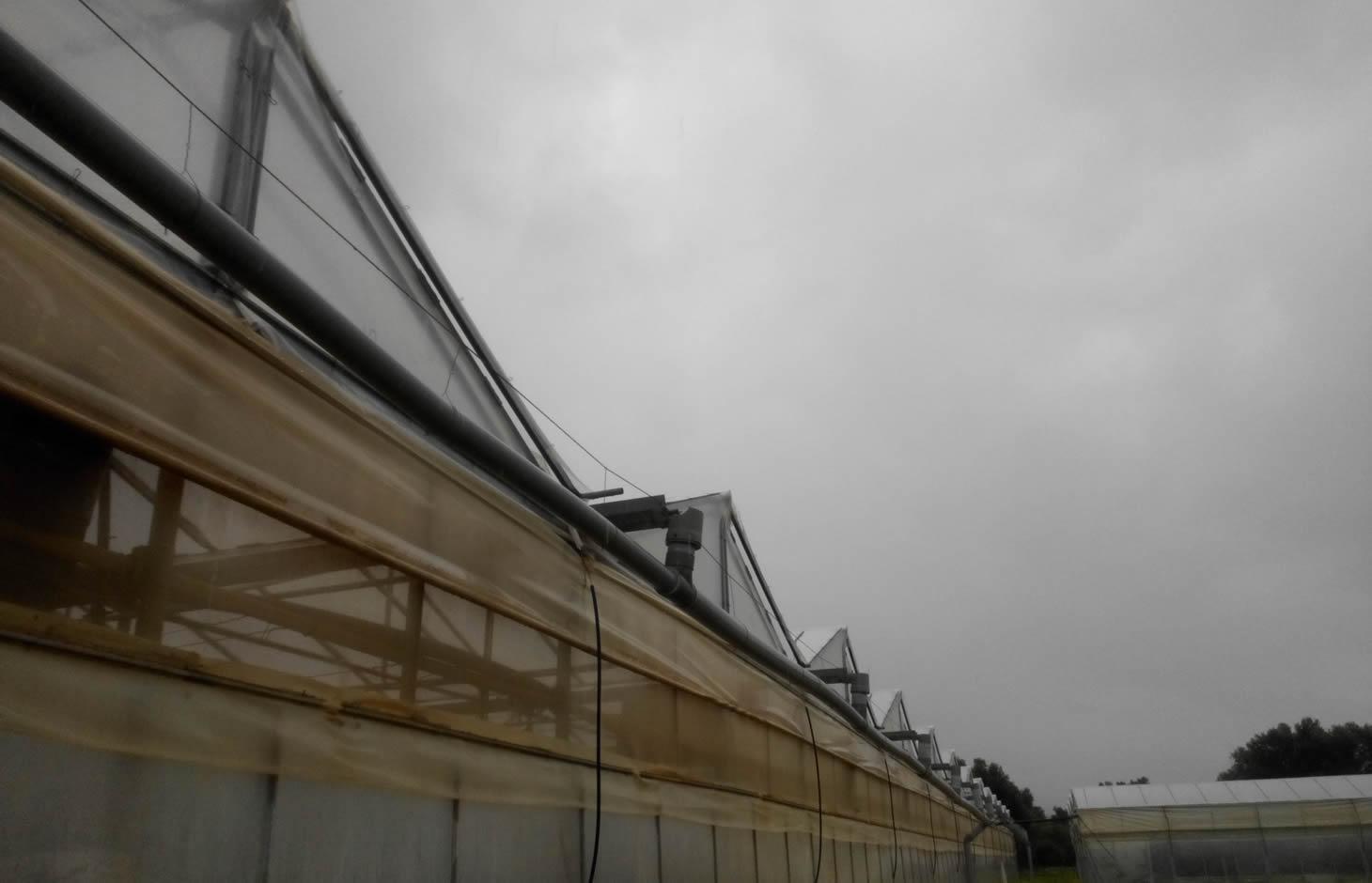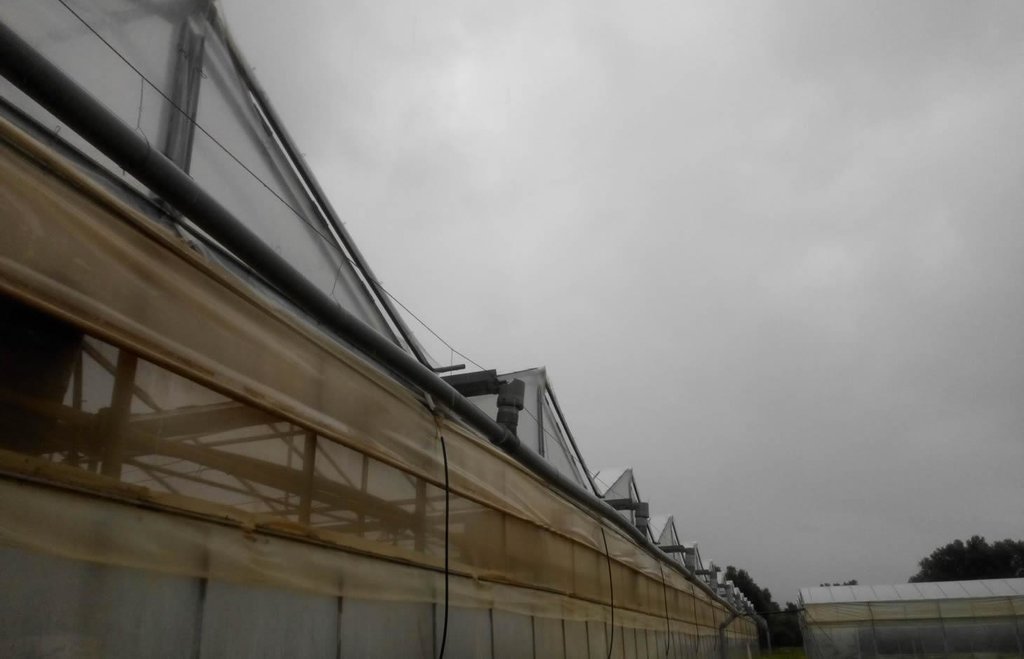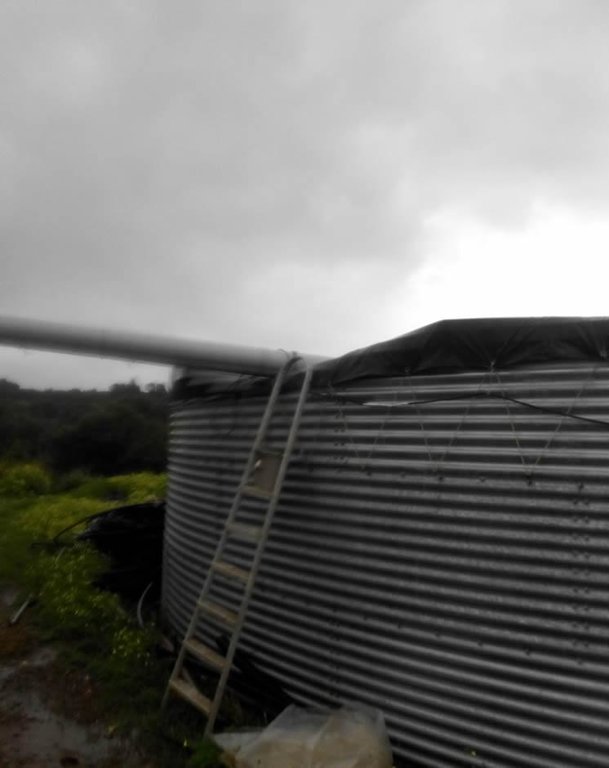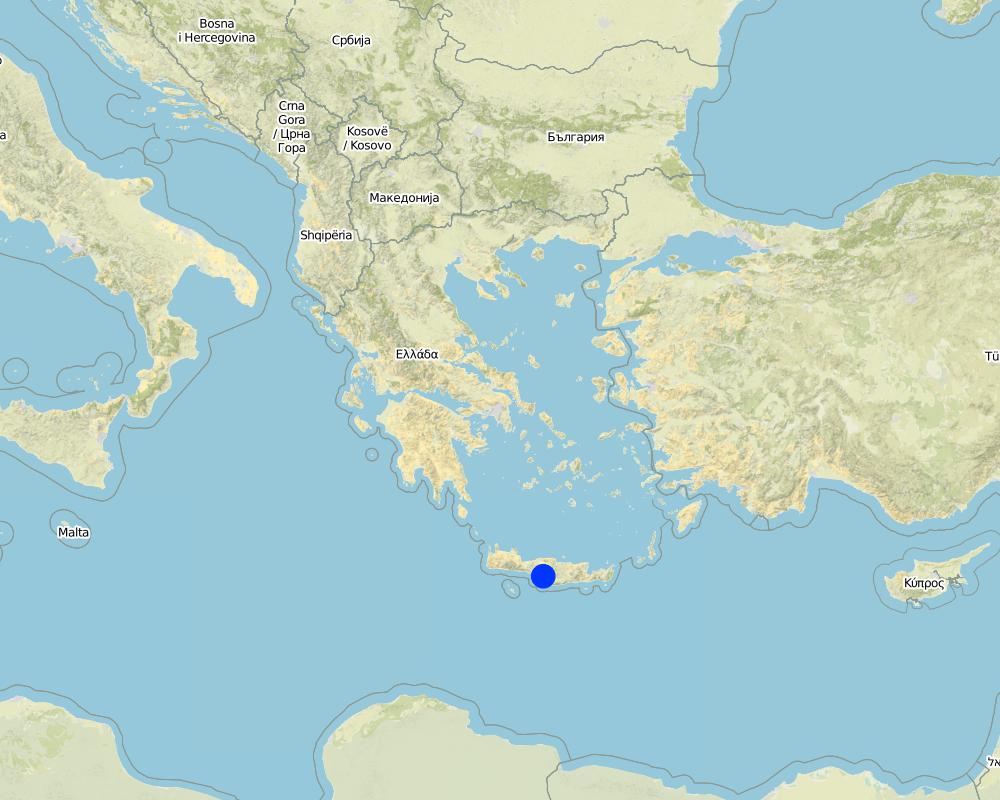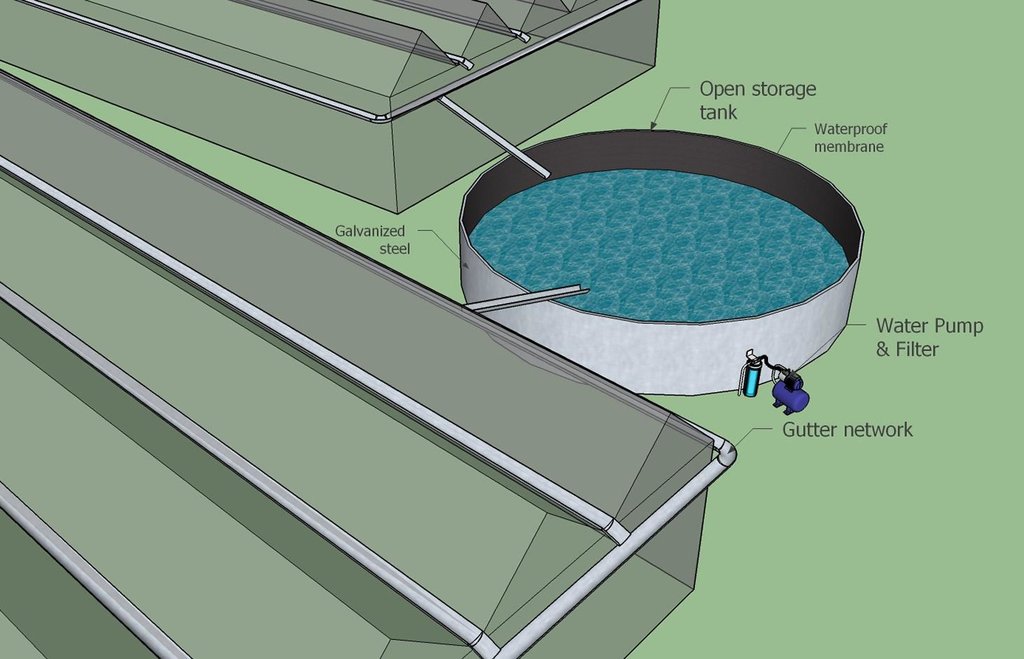Rainwater harvesting for greenhouse irrigation [希腊]
- 创建:
- 更新:
- 编制者: Ioanna Panagea
- 编辑者: –
- 审查者: Deborah Niggli, Alexandra Gavilano
Σύστημα συγκομιδής ομβρίων υδάτων από θερμοκήπια με σκοπό την άρδευση
technologies_1658 - 希腊
查看章节
全部展开 全部收起1. 一般信息
1.2 参与该技术评估和文件编制的资源人员和机构的联系方式
SLM专业人员:
有助于对技术进行记录/评估的项目名称(如相关)
Preventing and Remediating degradation of soils in Europe through Land Care (EU-RECARE )有助于对技术进行记录/评估的机构名称(如相关)
Technical University of Crete (Technical University of Crete) - 希腊1.3 关于使用通过WOCAT记录的数据的条件
编制者和关键资源人员接受有关使用通过WOCAT记录数据的条件。:
是
1.4 所述技术的可持续性声明
这里所描述的技术在土地退化方面是否存在问题,导致无法被认为是一种可持续的土地管理技术?:
否
2. SLM技术的说明
2.1 技术简介
技术定义:
Rain water harvesting from greenhouses roofs.
2.2 技术的详细说明
说明:
The roof of a greenhouse is used as catchment area for rainwater harvesting. A system of gutters is installed to channel water into a storage facility that can be either above ground or at ground level, open or covered. The water harvested from the roofs is used for irrigation purposes, either on its own or mixed with other sources.
In central and eastern Crete, a negative water balance emerges due to agricultural exploitation and lack of sustainable water resources management. Regarding water availability, it is notable that the spatial and temporal variability of precipitation are the limiting factors, rather than overall precipitation quantity. Especially in coastal areas where the main source of irrigation is groundwater, seawater intrusion often takes place, and eventually leading to irrigation with saline water. In the intensive agriculture and water stress conditions existing in greenhouses this situation can progressively lead to soil salinisation with subsequent adverse effects on production. The technology promotes sustainable land management through prevention and mitigation of land degradation by increasing water resources self-sufficiency thus allowing the user to rely less on the scarce groundwater resources and reduce the risk of production failure. Furthermore, the technology improves the overall irrigation water quality. The main disadvantage of the technology is the increase of agricultural inputs (fertilizers) because of the lack of minerals necessary for the crops (especially tomatoes) in the rainwater. This disadvantage can be mitigated by mixing rainwater with other sources.
The majority of the greenhouses in the region normally have built-in gutters between the basic construction units in order to discharge rainwater from the roof for structural safety. Thus, initially little structural measures are required including the implementation of some further gutters that channel rainwater in the storage system and preparation of the area for the tank installation. Overland tanks may consist of galvanized steel or similar material. Ground level storage usually requires earth removal. In both case, the installation of the relevant waterproofing material is required to avoid leaks. A cover may also be installed to reduce evaporation. Here we assess the use of a harvesting system comprising of (a) an above ground circular tank made out of galvanized steel with total volume of 320 m3 and (b) a gutter network spreading on the roof of a 0.7 ha greenhouse. Furthermore, a water filter and water treatment may be required for removal of particles and waterborne disease mitigation. Finally, a suitable pump and mixing facilities are installed to control water quality and quantity.
The average annual precipitation in the area is 500 mm and the climate ranges between sub-humid Mediterranean and semi-arid. Average annual temperature is 18.5 °C with 6 months below 18 °C but above 5 °C, thus classifying the area as subtropical. In the location where the technology is applied, land is mostly privately owned and water rights can be public, cooperative or private. Although the financial means of the land user who applies this technology are more or less on par with those of the rest of the community, he has a wider empirical education and relatively higher social status acquired thought his involvement with the commons and the water resources management of the region.
This Technology was documented within the scope of FP7 RECARE Project, funded grant agreement no 603498.
2.3 技术照片
2.5 已应用该技术的、本评估所涵盖的国家/地区/地点
国家:
希腊
区域/州/省:
Heraklion
有关地点的进一步说明:
Timpaki
注释:
Total area covered by the SLM Technology is 0.007 km2.
Map
×2.6 实施日期
如果不知道确切的年份,请说明大概的日期:
- 10-50年前
2.7 技术介绍
详细说明该技术是如何引入的:
- 通过项目/外部干预
注释(项目类型等):
The land user has implemented the water harvesting technology in order to be subsidized from an agri-environmental scheme under the CAP.
3. SLM技术的分类
3.2 应用该技术的当前土地利用类型

农田
- 一年一作
- tomatoes
每年的生长季节数:
- 1
具体说明:
Longest growing period in days: 270, Longest growing period from month to month: October to June

定居点、基础设施
- 定居点、建筑物
注释:
Major land use problems (compiler’s opinion): The main problem in the region is the change in the groundwater quality, caused by groundwater over-exploitation and the subsequent seawater intrusion, resulting in soil salinisation through irrigation.
Major land use problems (land users’ perception): The limited availability of good quality (non-saline) water for irrigation resulting in increased production risk and agricultural inputs.
3.4 供水
该技术所应用土地的供水:
- 充分灌溉
3.5 该技术所属的SLM组
- 集水
- 灌溉管理(包括供水、排水)
3.6 包含该技术的可持续土地管理措施

结构措施
- S5:大坝、集水斗、水池
- S11:其它
注释:
Main measures: structural measures
Specification of other structural measures: Greenhouse roof gutter network
3.7 该技术强调的主要土地退化类型

化学性土壤退化
- Cs:盐化/碱化

生物性退化
- Bq:数量/生物量减少

水质恶化
- Hg:地下水/含水层水位的变化
注释:
Main type of degradation addressed: Cs: salinisation / alkalinisation, Hg: change in groundwater / aquifer level
Secondary types of degradation addressed: Bq: quantity / biomass decline
Main causes of degradation: over abstraction / excessive withdrawal of water (for irrigation, industry, etc.) (Overpumping.), other human induced causes (specify) (Irrigation with brackish water.), droughts (Lack of sustainable water resources.), inputs and infrastructure: (roads, markets, distribution of water points, other, …) (Poor coverage of freshwater irrigation network.)
Secondary causes of degradation: soil management (Intensive cultivation), disturbance of water cycle (infiltration / runoff) (Covering of land with green houses decreases leaching.)
3.8 防止、减少或恢复土地退化
具体数量名该技术与土地退化有关的目标:
- 防止土地退化
- 减少土地退化
4. 技术规范、实施活动、投入和成本
4.1 该技术的技术图纸
技术规范(与技术图纸相关):
A network of gutters channels rainwater to an adequately insulated metal tank. The stored water is then used for irrigation.
Location: Timpaki. Heraklion, Crete, Greece
Date: 31/3/2015
Technical knowledge required for field staff / advisors: moderate
Technical knowledge required for land users: moderate
Main technical functions: water harvesting / increase water supply, improvement of water quality, buffering / filtering water
Secondary technical functions: increase of groundwater level / recharge of groundwater
Dam/ pan/ pond
Height of bunds/banks/others (m): 2.7
Width of bunds/banks/others (m): 12.3
Structural measure: gutter network
Length of bunds/banks/others (m): 210
Construction material (other): Plastic gutters on the greenhouses roofs, galvanized steel & wateproof membrane for the tank
Specification of dams/ pans/ ponds: Capacity 320m3
Catchment area: 7000m2m2
Beneficial area: 7000m2m2
For water harvesting: the ratio between the area where the harvested water is applied and the total area from which water is collected is: 1:1
作者:
Ioannis Daliakopoulos
4.2 有关投入和成本计算的一般信息
其它/国家货币(具体说明):
Euro
如相关,注明美元与当地货币的汇率(例如1美元=79.9巴西雷亚尔):1美元=:
0.93
4.3 技术建立活动
| 活动 | 时间(季度) | |
|---|---|---|
| 1. | Construction of the tank base (including material transportation) | |
| 2. | Tank construction (including material transportation) | |
| 3. | Installation of the plastic gutters | |
| 4. | Pump and cleaning filter |
4.4 技术建立所需要的费用和投入
| 对投入进行具体说明 | 单位 | 数量 | 单位成本 | 每项投入的总成本 | 土地使用者承担的成本% | |
|---|---|---|---|---|---|---|
| 劳动力 | Labour | 1.0 | 858.0 | 858.0 | 60.0 | |
| 设备 | pump | 1.0 | 536.0 | 536.0 | 60.0 | |
| 设备 | cleaning filter | 1.0 | 536.0 | 536.0 | 60.0 | |
| 施工材料 | galvanized steel | 1.0 | 3379.0 | 3379.0 | 60.0 | |
| 施工材料 | waterproof membrane | 1.0 | 2360.0 | 2360.0 | 60.0 | |
| 施工材料 | sand | 1.0 | 675.0 | 675.0 | 60.0 | |
| 施工材料 | concrete | 1.0 | 290.0 | 290.0 | 60.0 | |
| 其它 | gutters | 1.0 | 2252.0 | 2252.0 | 60.0 | |
| 技术建立所需总成本 | 10886.0 | |||||
| 技术建立总成本,美元 | 11705.38 | |||||
注释:
Duration of establishment phase: 0.5 month(s)
4.5 维护/经常性活动
| 活动 | 时间/频率 | |
|---|---|---|
| 1. | Maintenance costs are negligible, e.g. filters are cleaned with water when needed. Fuel can't be accurately estimated as it depends on the machine hours that the pump works to irrigate. Two considerations: 1.Practically, the pump would have to work regardless of the water harvesting system. 2.The water harvesting system is irrelevant of the pumping scheme. |
4.6 维护/经常性活动所需要的费用和投入(每年)
注释:
The cost described are calculated in current prices for the whole construction.
4.7 影响成本的最重要因素
描述影响成本的最决定性因素:
The greater deterrent against implementing the technology is the high cost of the tank construction.
5. 自然和人文环境
5.1 气候
年降雨量
- < 250毫米
- 251-500毫米
- 501-750毫米
- 751-1,000毫米
- 1,001-1,500毫米
- 1,501-2,000毫米
- 2,001-3,000毫米
- 3,001-4,000毫米
- > 4,000毫米
有关降雨的规范/注释:
About 400-500 mm annually
农业气候带
- 半湿润
- 半干旱
Thermal climate class: subtropics. 6 months below 18 °C but above 5 °C
5.2 地形
平均坡度:
- 水平(0-2%)
- 缓降(3-5%)
- 平缓(6-10%)
- 滚坡(11-15%)
- 崎岖(16-30%)
- 陡峭(31-60%)
- 非常陡峭(>60%)
地形:
- 高原/平原
- 山脊
- 山坡
- 山地斜坡
- 麓坡
- 谷底
垂直分布带:
- 0-100 m a.s.l.
- 101-500 m a.s.l.
- 501-1,000 m a.s.l.
- 1,001-1,500 m a.s.l.
- 1,501-2,000 m a.s.l.
- 2,001-2,500 m a.s.l.
- 2,501-3,000 m a.s.l.
- 3,001-4,000 m a.s.l.
- > 4,000 m a.s.l.
5.3 土壤
平均土层深度:
- 非常浅(0-20厘米)
- 浅(21-50厘米)
- 中等深度(51-80厘米)
- 深(81-120厘米)
- 非常深(> 120厘米)
土壤质地(表土):
- 中粒(壤土、粉土)
表土有机质:
- 高(>3%)
如有可能,附上完整的土壤描述或具体说明可用的信息,例如土壤类型、土壤酸碱度、阳离子交换能力、氮、盐度等。:
Soil texture characterized mainly as sandy clay loam or clay loam
5.4 水资源可用性和质量
地下水位表:
5-50米
地表水的可用性:
中等
水质(未处理):
仅供农业使用(灌溉)
关于水质和水量的注释和进一步规范:
Water quality (treated): good drinking water
5.5 生物多样性
物种多样性:
- 低
5.6 应用该技术的土地使用者的特征
定栖或游牧:
- 定栖的
生产系统的市场定位:
- 商业/市场
非农收入:
- 低于全部收入的10%
相对财富水平:
- 平均水平
- 丰富
个人或集体:
- 个人/家庭
机械化水平:
- 手工作业
- 机械化/电动
性别:
- 男人
说明土地使用者的其他有关特征:
Land users applying the Technology are mainly common / average land users
Population density: 10-50 persons/km2
Annual population growth: 1% - 2%
5.7 应用该技术的土地使用者使用的平均土地面积
- < 0.5 公顷
- 0.5-1 公顷
- 1-2 公顷
- 2-5公顷
- 5-15公顷
- 15-50公顷
- 50-100公顷
- 100-500公顷
- 500-1,000公顷
- 1,000-10,000公顷
- > 10,000公顷
这被认为是小规模、中规模还是大规模的(参照当地实际情况)?:
- 中等规模的
5.8 土地所有权、土地使用权和水使用权
土地所有权:
- 个人,有命名
土地使用权:
- 租赁
- 个人
- Cooperative
用水权:
- 社区(有组织)
- 个人
- Cooperative
5.9 进入服务和基础设施的通道
健康:
- 贫瘠
- 适度的
- 好
教育:
- 贫瘠
- 适度的
- 好
技术援助:
- 贫瘠
- 适度的
- 好
就业(例如非农):
- 贫瘠
- 适度的
- 好
市场:
- 贫瘠
- 适度的
- 好
能源:
- 贫瘠
- 适度的
- 好
道路和交通:
- 贫瘠
- 适度的
- 好
饮用水和卫生设施:
- 贫瘠
- 适度的
- 好
金融服务:
- 贫瘠
- 适度的
- 好
6. 影响和结论性说明
6.1 该技术的现场影响
社会经济效应
生产
作物生产
生产故障风险
收入和成本
农业投入费用
注释/具体说明:
softer water (rainwater) requires more expensive fertilisers
其它社会经济效应
production area
注释/具体说明:
Depending on relative farm size.
社会文化影响
食品安全/自给自足
SLM/土地退化知识
Contribution to human well-being
注释/具体说明:
The technology reduces production risk and increases self sufficiency for the user who implements it. If the technology is widely implemented this will have a positive impact on the soil sustainability of the area thus allowing agricultural exploitation for longer. It will also greatly reduce water use conflicts, thus contributing to the general well-being of the local community.
生态影响
水循环/径流
水量
水质
水的回收/收集
土壤
土壤水分
盐度
6.2 该技术的场外影响已经显现
水资源可用性
对邻近农田的破坏
注释/具体说明:
control of the water from the greenhouses roofs.
对公共/私人基础设施的破坏
注释/具体说明:
control of the water from the greenhouses roofs.
6.3 技术对渐变气候以及与气候相关的极端情况/灾害的暴露和敏感性(土地使用者认为的极端情况/灾害)
渐变气候
渐变气候
| 季节 | 增加或减少 | 该技术是如何应对的? | |
|---|---|---|---|
| 年温度 | 增加 | 好 |
气候有关的极端情况(灾害)
气候灾害
| 该技术是如何应对的? | |
|---|---|
| 干旱 | 不好 |
其他气候相关的后果
其他气候相关的后果
| 该技术是如何应对的? | |
|---|---|
| Decrease of water temperature | 不好 |
注释:
The optimum water temperature for the crops cultivated in the greenhouse (tomatoes) is about 20 °C. If water temperature is less than 14 °C then the land user has to rely on an alternative source.
6.4 成本效益分析
技术收益与技术建立成本相比如何(从土地使用者的角度看)?
短期回报:
消极
长期回报:
积极
技术收益与技术维护成本/经常性成本相比如何(从土地使用者的角度看)?
短期回报:
积极
长期回报:
非常积极
注释:
In the long term soil health is greatly maintained.
6.5 技术采用
- > 50%
如若可行,进行量化(住户数量和/或覆盖面积):
70% or 7 land user families
在所有采用这项技术的人当中,有多少人是自发的,即未获得任何物质奖励/付款?:
- 11-50%
注释:
30% of land user families have adopted the Technology without any external material support
3 land user families have adopted the Technology without any external material support
Comments on spontaneous adoption: Land users are probably not able to afford or justify the cost without external material support.
There is a little trend towards spontaneous adoption of the Technology
Comments on adoption trend: Word of mouth conveys the successful results and several users are eager to adopt the technology but not without external material support.
6.7 该技术的优点/长处/机会
| 土地使用者眼中的长处/优势/机会 |
|---|
| Increased irrigation water availability, and security; reduced crop failure risk; ability to diversify or intensify production |
| 编制者或其他关键资源人员认为的长处/优势/机会 |
|---|
| Self-sufficiency of water; sustainable agriculture management (soil protection and conservation) and reduced failure risk; decreased soil salinity |
6.8 技术的弱点/缺点/风险及其克服方法
| 土地使用者认为的弱点/缺点/风险 | 如何克服它们? |
|---|---|
| High construction cost. | The construction of a water harvesting system for greenhouses can be subsidized. |
| Tomato cultivation requires water with higher electric conductivity than that of rainwater, therefore increased agricultural inputs may be required to treat the harvested rainwater. | Rainwater may be mixed with brackish water at a prescribed ratio. |
| 编制者或其他关键资源人员认为的弱点/缺点/风险 | 如何克服它们? |
|---|---|
| Is dependent on climatic conditions (precipitation/evaporation) | During dry years the storage tank can be used as a buffer from other sources. Installing a cover reduces evaporation. |
| High construction cost. | The construction of a water harvesting system for greenhouses can be made obligatory. |
| The storage area decreases the area available for cultivation (or can't be established in very small properties) |
7. 参考和链接
7.1 信息的方法/来源
- 实地考察、实地调查
- 与土地使用者的访谈
(现场)数据是什么时候汇编的?:
06/03/2015
链接和模块
全部展开 全部收起链接
无链接
模块
无模块


